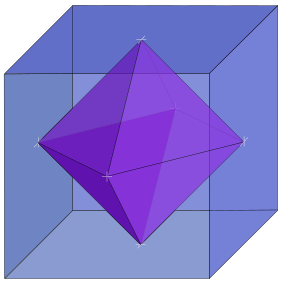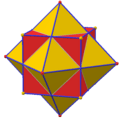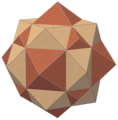Dual polyhedron facts for kids
A dual polyhedron is a special partner shape in geometry. Imagine you have a 3D shape, like a cube. Its dual is another shape, like an octahedron. What makes them partners? The points (called vertices) of one shape match up with the flat surfaces (called faces) of the other. Also, the lines (called edges) connecting vertices in one shape match the edges connecting faces in the other. If you find the dual of a dual shape, you get back to the original shape!
Platonic Solids and Their Duals
Platonic solids are five very special 3D shapes. They are perfectly symmetrical. For these five shapes, only the tetrahedron is its own dual. This means if you find the dual of a tetrahedron, you get another tetrahedron!
Other Platonic solids have different shapes as their duals:
- The cube and the octahedron are duals of each other.
- The dodecahedron and the icosahedron are duals of each other.
This table shows the Platonic solids and their duals, along with how many vertices, edges, and faces each has:
| Polyhedron | Vertices | Edges | Faces | Dual |
|---|---|---|---|---|
| Tetrahedron | 4 | 6 | 4 | Tetrahedron |
| Cube | 8 | 12 | 6 | Octahedron |
| Octahedron | 6 | 12 | 8 | Cube |
| Dodecahedron | 20 | 30 | 12 | Icosahedron |
| Icosahedron | 12 | 30 | 20 | Dodecahedron |
Images for kids
-
The dual of a cube is an octahedron. Vertices of one correspond to faces of the other, and edges correspond to each other.
-
The dual of a Platonic solid can be constructed by connecting the face centers. In general this creates only a topological dual. Images from Kepler's Harmonices Mundi (1619)
See also
 In Spanish: Poliedro conjugado para niños
In Spanish: Poliedro conjugado para niños







